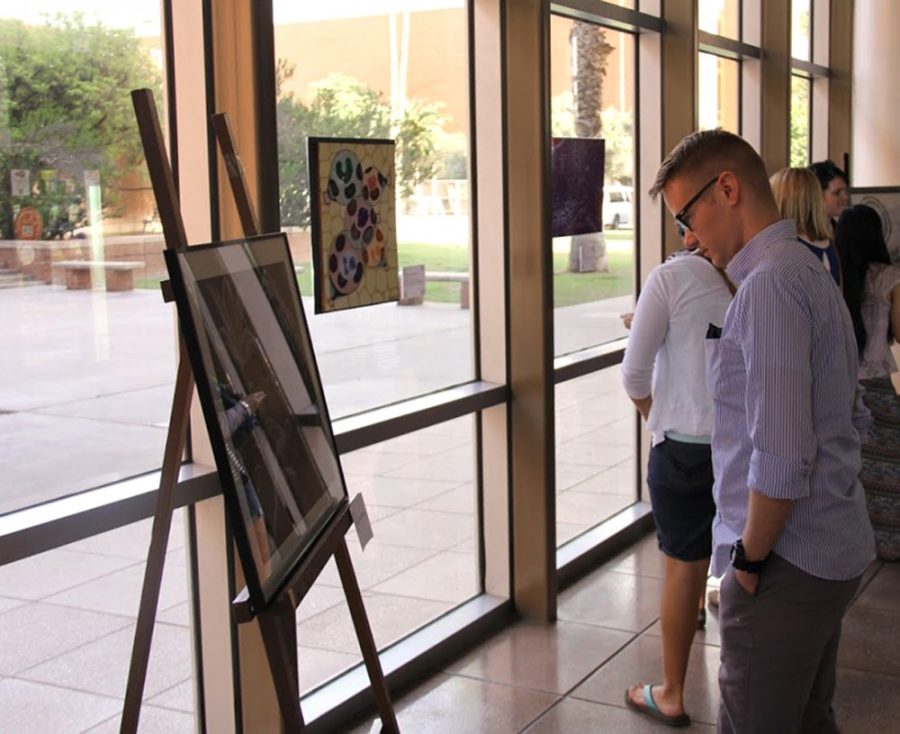From 3-D-printed sculptures of aquatic organisms to pink paint made from crushed bollworms, the neuroscience department’s first-ever science-inspired showcase, held on Monday from 5-7 p.m. in the lobby of the Gould-Simpson building, proved that science and art are not exclusive.
The showcase, titled “Symbiosis: An Exhibit of Biological Art,” was open to the public, and both artists and scientists were encouraged to submit their own work. The event was a collaboration between the Neuroscience & Cognitive Science Ambassadors and the UA chapter of Nu Rho Psi, which is a national honor society dedicated to neuroscience.
“The term [symbiosis, for us] is actually dealing with sort of the cohesive existence between two things in a general nature, so in this case, it’s science and art,” said Kendra Liu, a neuroscience and cognitive science senior, NSCS ambassador and vice president of Nu Rho Psi. “… We have everything from artists’ interpretation of science to actual confocal images of brains.”
Art pieces ranged from paintings to 3-D-printed pieces of art, and the artists consisted of undergraduate and graduate students, UA faculty and staff and even local Tucson artists.
“One thing about neuroscience and cognitive science is that it combines two disciplines that usually are separated, but this is another way to bring together two things that some people think are so far [or] distant from each other, and yet here we are with beautiful art connected to science,” said Tazheh Kaboosi, a junior studying neuroscience and cognitive science, Nu Rho Psi member and NSCS ambassador.
UA alumnus Robert Long presented portions of his master’s thesis that he said he felt embodied the theme of symbiosis, bringing together graphite and digital color prints of a red snapper fish, a bobtail squid and an octopus. Also included were 3-D plastic sculptures of certain organs of the organisms in question.
“Each print exemplifies a relationship,” Long said. “So the one on the right is a red snapper with a tongue eating louse, and that’s a parasitic relationship. And then for the sculpture, it’s the mouth and the gills of the fish, and for the other one, it’s a mutualistic relationship. It’s a squid and beneficial bacteria that help camouflage the squid so the sculpture that accompanies that is the light organ where the squid kind of grows and feeds the bacteria.”
Like Long, others were equally inventive with their pieces for the showcase. Sarah Balmquist, a sophomore studying molecular and cellular biology and neuroscience and cognitive science, utilized overflow pink bollworms from her entomology lab in her painting.
“The pupae are especially juicy — that’s the only way to put it — and I literally had to crunch them up, although I just want to mention that they were dead before this happened,” Balmquist said. “This was a little different because it was a little more personal to me and my lab work.”
According to Liu, who helped organize the event, the art showcase also acted as a fundraiser for the neuroscience and cognitive science program. Artists were allowed to sell their art at the event, with 10 percent of the proceeds going towards the student activities fund for the NSCS department. Prices ranged from under $100 to above $700. Some artists donated their art to be raffled off at the end of the event.
The NSCS ambassadors and Nu Rho Psi plan to hold another art showcase some time next year.
“I think it is a really great way to bring together the UA community and the local Tucson community with events like this,” said Becca Van Sickler, NSCS program coordinator and NCSC academic advisor. “It just really makes that connection between the UA, and that’s something that we really want to encourage.”
_______________
Follow Connie Tran on Twitter.









